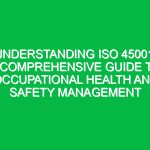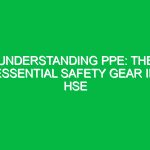Introduction to Personal Protective Equipment (PPE)
In the landscape of health, safety, and environment (HSE) compliance, personal protective equipment (PPE) plays a pivotal role in safeguarding individuals from potential hazards. Defined as any equipment designed to be worn or held by a person to protect against health or safety risks, PPE is more than just gear; it represents a critical line of defense in various work environments. From construction sites to laboratories, the right PPE can mean the difference between safety and serious injury, making it indispensable for compliance with HSE regulations.
Consider a construction worker atop a high-rise building. The wind whips past, and the sound of machinery fills the air. Without a hard hat, safety goggles, and a harness, the risk of accidents escalates dramatically. This scenario highlights the importance of PPE, not only for compliance but for the well-being of workers. In this article, we will dive deep into the various types of personal protective equipment, the risks they mitigate, safety precautions, and the regulations governing their use.
Understanding the Hazards and Risks
Every workplace harbors its unique set of hazards. Identifying these risks is crucial for selecting the appropriate PPE. These hazards are generally categorized into several types:
Physical Hazards
Physical hazards include anything that can lead to immediate physical harm. This could be falling objects on a construction site or sharp tools in a manufacturing environment. The risks often involve:
- Head injuries from falling debris, necessitating the use of hard hats.
- Foot injuries from heavy machinery, requiring steel-toed boots.
- Hearing damage from loud machinery, leading to the use of earmuffs or earplugs.
Chemical Hazards
Chemicals can pose a range of risks, from skin irritation to respiratory issues. Workers in laboratories or factories often face exposure to harmful substances. Common risks include:
- Skin contact with corrosive substances, necessitating gloves and protective clothing.
- Inhalation of toxic fumes, requiring respirators or masks.
Biological Hazards
In sectors like healthcare or agriculture, biological hazards are prevalent. Workers might encounter pathogens that can lead to severe health issues. Key risks involve:
- Exposure to blood or bodily fluids, necessitating gloves and face shields.
- Handling infectious materials, requiring specialized masks and gowns.
Psycho-Social Hazards
While they may not require physical gear, psycho-social hazards can affect mental health and overall well-being. Stressful work environments can lead to burnout, which is another kind of risk that organizations must address.
Best Practices for Using Personal Protective Equipment
With the risks identified, it’s essential to implement best practices for using PPE effectively. Here are essential tips to ensure safety:
1. Conduct a Risk Assessment
Before selecting PPE, conduct a thorough risk assessment. This involves identifying hazards specific to your workplace and evaluating the level of risk associated with them. For example, in a manufacturing plant, a risk assessment might reveal the need for eye protection when operating machinery.
2. Choose the Right PPE
Not all PPE is suitable for every situation. It’s crucial to select equipment that fits the specific hazards identified. For instance, a construction worker would require a different type of helmet compared to someone in a laboratory setting. Always consider the following:
- Comfort and fit: Ill-fitting gear can lead to non-compliance or improper usage.
- Material: Ensure the PPE is made from suitable materials that can withstand the exposure it will face.
3. Training and Education
Employees must be trained on the proper usage of PPE. This includes understanding how to wear, maintain, and store the equipment correctly. For example, a worker might need to know how to properly fit a respirator to ensure it provides adequate protection.
4. Regular Inspection and Maintenance
PPE should be regularly inspected for wear and tear. A cracked helmet or torn gloves can render the equipment ineffective. Create a schedule for inspecting PPE and replace any damaged items immediately.
5. Foster a Safety Culture
Encouraging a culture of safety within the workplace can bolster compliance with PPE regulations. When employees feel that safety is a priority, they are more likely to adhere to PPE guidelines. This can be fostered through regular safety meetings, training sessions, and open discussions about safety concerns.
Regulations and Standards Governing Personal Protective Equipment
Compliance with regulations is a non-negotiable aspect of workplace safety. Various organizations and governments have established standards to guide the use of PPE. Some key regulations include:
1. Occupational Safety and Health Administration (OSHA)
In the United States, OSHA sets and enforces standards to ensure safe working conditions. They mandate that employers provide appropriate PPE to employees at no cost. This includes guidelines for specific industries, such as construction, agriculture, and healthcare.
2. European Union Personal Protective Equipment Regulation (EU PPE Regulation 2016/425)
This regulation outlines the essential health and safety requirements for PPE manufactured and sold in the European Union. It ensures that PPE meets specific performance standards before being placed on the market.
3. American National Standards Institute (ANSI)
ANSI develops consensus standards for various types of PPE, ensuring that products meet established safety criteria. Compliance with ANSI standards is often a requirement for organizations to maintain HSE compliance.
Conclusion: The Imperative of Personal Protective Equipment
In conclusion, personal protective equipment is a cornerstone of health, safety, and environmental compliance. By understanding the hazards present in the workplace, selecting the appropriate equipment, and adhering to best practices, organizations can foster a safer work environment. Compliance with established regulations not only protects employees but also enhances overall productivity and morale.
As industries evolve and new risks emerge, staying informed about PPE advancements and regulations is essential. The commitment to protecting workers with the right personal protective equipment is not just a legal obligation; it’s a moral one. In every scenario, from the construction site to the laboratory, the safety of individuals hinges on the effective use of PPE.


